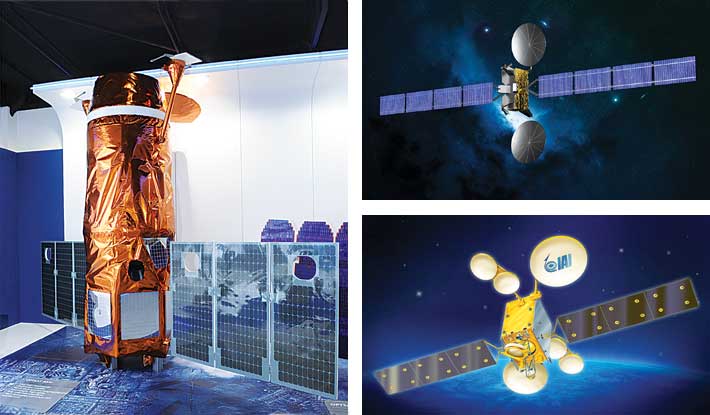- Prime Minister Narendra Modi inaugurates Aero India 2023 in Bengaluru; Releases Commemorative Stamp
- Defence Secretary meets delegations from Saudi Arabia, USA and Oman on the sidelines of Aero India 2023
- Foreign Ministers of 32 countries to attend Aero India 2023
- Embraer showcases the C-390 Millennium at Aero India 2023
IAI Satellites – Leading in Space Development
IAI space prowess is demonstrated in +40 years of experience and expertise in space technologies and New Space approach to achieve top-tier performance

Seeking to reach the highest frontier, IAI pioneered missions in space in 1988, placing Israel's first satellite, OFEQ-1, in low earth orbit. Today, IAI is a satellite powerhouse, having placed dozens of reconnaissance, communications, and scientific research satellites in orbit.
IAI's OptSat line of reconnaissance satellites has evolved over generations, and it is currently positioned at the forefront of high-resolution imaging satellites used by intelligence services worldwide. In the 21st-century combat arena, the ability to quickly receive and utilise intelligence data from space is becoming increasingly central to the success of warfare operations worldwide. Imagery consumers are accustomed to obtaining satellite imagery at high resolution to provide clear, accurate, well-defined images enabling extraction of fine details from satellite images.
With an image resolution range of more than / higher than 40 centimeters, with geo-location accuracy, IAI's OptSat 3000 is significantly lighter than equivalent satellites with the same performance levels. Due to its lower mass and higher agility, it acquires images of many more targets with agility, throughput, and advanced operational autonomy. OptSat 3000 provides imagery for strategic and tactical intelligence, where rapid, precise visual intelligence on suspicious targets is critical to a mission's success. IAI is also developing nano and microsatellites. The 25 kg OptSat 180 is packaged in a CubeSat standard (12U), offering a wide range of launch options. The satellite delivers live video and color images in a resolution of one meter, with sensors suitable for reconnaissance, research, and science.
IAI also designs and manufactures Synthetic aperture radar (SAR) satellites enhancing the intelligence collection capabilities at night and above cloud coverage. These satellites provide resolutions and detection capabilities that significantly boost the users' ability to monitor large areas, supporting strategic surveillance and tactical operations. SAR products are enhanced by image processing algorithms enabling automatic change detection and identification of typical man-made objects such as missile launchers, vehicles, and ships. Like other IAI satellite platforms, TecSar is significantly smaller, lighter, and more maneuverable than other satellites in their category.
IAI also provides communications satellites and has recently unveiled several new space concepts, including the Mini-Communication Satellite (MCS). It is unique due to its small size and light weight, and the MCS can be launched together in rideshare with other satellites, significantly lowering deployment costs. The MCS also has "space smartphone" capabilities, enabled by softwaredefined digital communication that allows operators to deploy frequent communication and updates. In addition, IAI has been commissioned to develop and build Israel's national communication satellite, Dror 1. The new satellite will carry an advanced digital communication payload, delivering communication agility throughout the satellite's lifetime in space. Dror 1 will provide Israel's communications needs for the next 15 years.
In 2019 IAI's Beresheet spaceship, co-developed by IAI and SpaceIL, attracted worldwide attention by flying 6.5 million kilometers to the moon (orbital route) in an attempt to land on the moon's surface. While the small spacecraft failed to complete a soft landing, the achievements demonstrated in this mission represent the team's innovative, technological, and engineering knowledge in building space vehicles. Weighing only 600 kilograms, it was the smallest spacecraft to attempt the moon landing, manifesting IAI's determination, achievements, and experience in building small, lightweight space vehicles.
Forty years after its first space mission, Beresheet was the first spacecraft to orbit the moon and attempt a landing as a private initiative rather than a government programme. Demonstrating the unique Israeli creative and innovative spirit, the spacecraft was developed and constructed within a few years at the cost of just 100 million US dollars - significantly cheaper than similar projects that have cost billions. IAI is working on the second lander, Beresheet 2, to complete the mission and continue Israel's proud space legacy.





